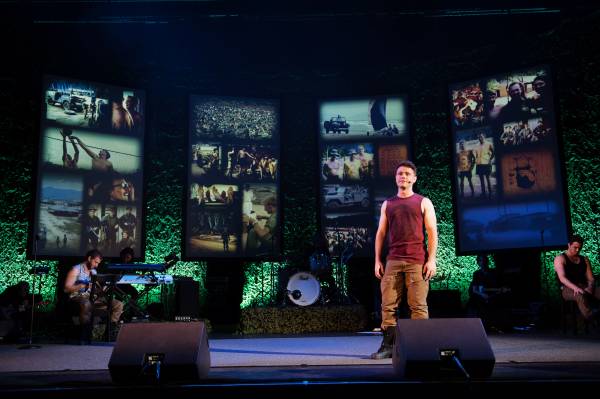State Theatre, August 29

This was balanced on a knife-edge. The show had to draw us into the lives of its characters instantly and make us care. Had it failed a score of rock, pop and soul songs from around 45 years ago would have been interrupted by people we didn’t want to know talking about themselves. Somehow it succeeded.
Describing itself as a “concert drama’ and subtitled Songs That Defined A Generation, Rolling Thunder Vietnam tells of three Vietnam War soldiers and the sweetheart one of them leaves behind. They could easily have been mere cardboard cut-outs, but writer Bryce Hallett skilfully and concisely delineates Andy (Wes Carr), Johnny, (Tom Oliver) Sarah (Kimberley Hodgson) and Thomas (Matt Pearce) in those opening minutes.
Conceived by Scott Barton and directed by David Berthold the show rides on classic songs like All Along The Watchtower, Born To Be Wild, Paint It Black and We Gotta Get Out Of This Place, and the music was mostly realised with panache. Too often rock-based musicals are blighted by limp accompaniment, but this band, led by Chong Lim, could give the material the Agent Orange treatment when required. Four lead and two backing singers ensured sufficient clout in the vocal department, too, with Carr standing out and Hodgson inclined to shriek.
The script – brief soliloquies or letters – actually compounded the songs’ power and poignancy, Hallett lacing his lines with specifics of a Vietnam soldier’s life rather than arm’s-length generalisations. The momentum slowed in Act Two, however, where a series of soul numbers were unconvincing. Berthold, meanwhile, let some musical-theatre tweeness invade a stage otherwise enjoying rock-concert aesthetics and energy, and some monologues about leave in Saigon needed cutting.
Both the soldiers’ and the anti-war protesters’ viewpoints were presented dispassionately. At the end the difficult issue of veterans returning from a discredited war was bravely confronted, and slow panning across still black-and-white photographs of some Diggers crowned the impressive big-screen visual component.